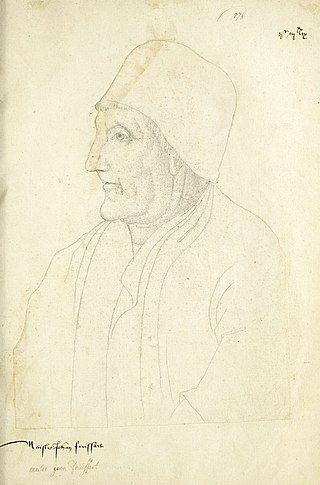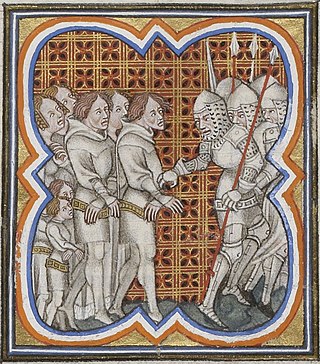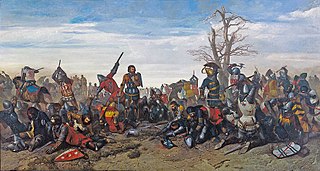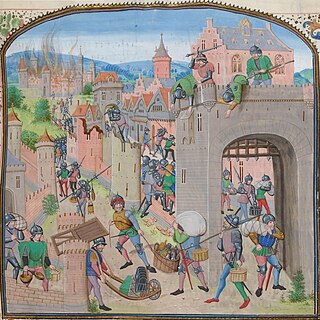
Jean Froissart was a French-speaking medieval author and court historian from the Low Countries who wrote several works, including Chronicles and Meliador, a long Arthurian romance, and a large body of poetry, both short lyrical forms as well as longer narrative poems. For centuries, Froissart's Chronicles have been recognised as the chief expression of the chivalric revival of the 14th-century kingdoms of England, France and Scotland. His history is also an important source for the first half of the Hundred Years' War.

Sir John Hawkwood was an English soldier who served as a mercenary leader or condottiero in Italy. As his name was difficult to pronounce for non-English-speaking contemporaries, there are many variations of it in the historical record. He often referred to himself as Haukevvod and in Italy, he was known as Giovanni Acuto, literally meaning "John Sharp" in reference to his "cleverness or cunning". His name was Latinised as Johannes Acutus. Other recorded forms are Aucgunctur, Haughd, Hauvod, Hankelvode, Augudh, Auchevud, Haukwode and Haucod. His exploits made him a man shrouded in myth in both England and Italy. Much of his enduring fame results from the surviving large and prominent fresco portrait of him in the Duomo, Florence, made in 1436 by Paolo Uccello, seen every year by 4½ million tourists.

The Jacquerie was a popular revolt by peasants that took place in northern France in the early summer of 1358 during the Hundred Years' War. The revolt was centred in the valley of the Oise north of Paris and was suppressed after over two months of violence. This rebellion became known as "the Jacquerie" because the nobles derided peasants as "Jacques" or "Jacques Bonhomme" for their padded surplice, called a "jacque". The aristocratic chronicler Jean Froissart and his source, the chronicle of Jean le Bel, referred to the leader of the revolt as Jacque Bonhomme, though in fact the Jacquerie 'great captain' was named Guillaume Cale. The word jacquerie became a synonym of peasant uprisings in general in both English and French.

The Combat of the Thirty, occurring on 26 March 1351, was an episode in the Breton War of Succession fought to determine who would rule the Duchy of Brittany. It was an arranged fight between selected combatants from both sides of the conflict, fought at a site midway between the Breton castles of Josselin and Ploërmel among 30 champions, knights, and squires on each side. The challenge was issued by Jean de Beaumanoir, a captain of Charles of Blois supported by King Philip VI of France, to Robert Bemborough, a captain of Jean de Montfort supported by Edward III of England.

The Battle of Nájera, also known as the Battle of Navarrete, was fought on 3 April 1367 to the northeast of Nájera, in the province of La Rioja, Castile. It was an episode of the first Castilian Civil War which confronted King Peter of Castile with his half-brother Count Henry of Trastámara who aspired to the throne; the war involved Castile in the Hundred Years' War. Castilian naval power, far superior to that of France or England, encouraged the two polities to take sides in the civil war, to gain control over the Castilian fleet.
Arnaud de Cervole, also de Cervolles, de Cervolle, Arnaut de Cervole or Arnold of Cervoles, known as l'Archiprêtre, was a French mercenary soldier and Brigand of the Hundred Years War in the 14th century.

A free company was an army of mercenaries between the 12th and 14th centuries recruited by private employers during wars. They acted independently of any government, and were thus "free". They regularly made a living by plunder when they were not employed; in France they were called routiers and écorcheurs and operated outside the highly structured law of arms. The term "free company" is most often applied to those companies of soldiers which formed after the Peace of Brétigny during the Hundred Years' War and were active mainly in France, but it has been applied to other companies, such as the Catalan Company and companies that operated elsewhere, such as in Italy and the Holy Roman Empire.
Tard-Venus were medieval groups of routiers that ravaged Europe in the later years of the reign of King John II of France.

Bascot de Mauléon was a Basque soldier, mercenary and Brigand of the Hundred Years' War in the 14th century.

Perin de Sasine, known by his alias Le Petit Meschin, was a French soldier, mercenary and brigand of the Hundred Years War in the 14th century.
The La Compagnia della Stella was the name of two separate companies of mercenary soldiers which operated in northern Italy at different times in the 14th century.
Albert Sterz was a German noble who was a leader of mercenary Free companies, primarily operating in Italy.

Hagre l'Escot was a Scottish mercenary captain during the Hundred Years War.

Francois Hennequin, was a mercenary captain during the Hundred Years War.

Naudon de Bageran, was a mercenary captain during the Hundred Years War.

Robert Birkhead (Briquet) was a mercenary captain during the Hundred Years War.

John Creswey was an English mercenary captain during the Hundred Years War.

Aymon of Ortinge, also known as Amanieu d'Ortigue or Amanieu de l'Artigue, was a French mercenary captain during the Hundred Years' War. His story is mentioned in the Chronicles of Froissart.

Bernard de la Salle, was a French mercenary captain during the Hundred Years War. His story is mentioned in the Chronicles of Froissart.

Bour de Breteuil was a mercenary captain of the Hundred Years War.







